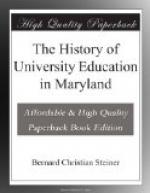This statement is not absolutely correct; it is probable that there was some catastrophe, and possibly Dr. Jennings then began to break away from the Methodist Episcopal Church, which he left entirely, when the Methodist Protestant Church was formed in 1828. Still some sort of an organization was kept up under the old name; for does not good Hezekiah Niles, of Register fame, tell us of examinations and exhibitions he witnessed in the early spring of 1819,[43] at which time prodigies of learning and cramming were exhibited, and do we not find in 1824, a pamphlet published by Dr. Jennings, entitled “Remarks on the Subject of Education, to which are added the general rules of the school under the appellation of Asbury College.” Apparently the College had passed entirely out of the control of the church, and having lowered its grade, was now little more than Dr. Jennings’ private school. The school was then situated on the corner of Charles and Baltimore Streets and, in 1833, when we catch the last glimpse of it, another removal had taken it to the corner of South and Fayette Streets. It was then merely a boys’ day school and doubtless soon perished. So the second Methodist College failed as the first had done and another was added to the many abortive attempts to found a college in Maryland.
OTHER EXTINCT COLLEGES.
Three other attempts to found colleges demand a passing notice.
Mount Hope College stood at the corner of Eutaw Place and North Avenue, and was charted as a college in 1833.[44] The building was constructed by the Baltimore branch of the United States Bank in 1800, during an epidemic of yellow fever in the city. People feared to come into town to transact business and so a suburban banking house was built. This building was bought by the Rev. Frederick Hall in 1828 and in it a school was begun, which was later expanded into the College. The institution lasted some ten years and is worthy of note from the fact that among the teachers were two young Yale graduates, who afterwards obtained considerable renown: Professor Elias Loomis and Rev. S.W.S. Dutton.
The College of St. James was situated in Washington County and was originally intended by its founder, Bishop Whittingham, as a preparatory school. It was opened in October, 1842, with Rev. J.B. Kerfoot,[45] afterwards Bishop of Pittsburg, as Principal, and had such speedy and encouraging success, that it was chartered as a college in 1843, under the control of the Protestant Episcopal Church.




